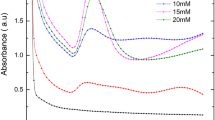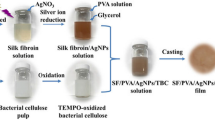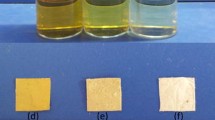Abstract
Biocompatible, small-sized but well-dispersed gold nanoparticles (Au NPs) remain a major challenge for their synthesis. Here a convenient solution impregnation technique is developed to prepare such Au NPs under the regulation of degummed silk fibroin fibers (SFFs) extracted from Bombyx mori cocoons. SFFs play multiple roles in the formation of Au NPs such as reactive substrate to capture AuCl4- ions by the chelation of -C = O, reducing agent for Au(0) by the reduction of -OH, and modifiers to render biocompatible Au NPs by some functional groups and biomolecules. The as-prepared Au NPs with a size of 7–10 nm are embedded in the solid SFF substrate, and can disperse well in the liquid system by the disintegration of SFFs into silk fibroin (SF) in a certain CaCl2 solution. The biocompatible Au NPs exhibit uniform small size and distribute stably in both solid and solution states, which have distinctive properties and functional advantages, and bring great convenience to their storage and transportation.
Similar content being viewed by others
References
Hayashi K, Nakamura M, Miki H, et al. Gold nanoparticle clusterplasmon-enhanced fluorescent silica core–shell nanoparticles for X-ray computed tomography-fluorescence dual-mode imaging of tumors. Chemical Communications, 2013, 49(46): 5334–5336
Lin W, Yang C, Xue Z, et al. Controlled construction of gold nanoparticles in situ from β-cyclodextrin based unimolecular micelles for in vitro computed tomography. Journal of Colloid and Interface Science, 2018, 528: 135–144
Ghosh P S, Kim C K, Han G, et al. Efficient gene delivery vectors by tuning the surface charge density of amino acid-functionalized gold nanoparticles. ACS Nano, 2008, 2(11): 2213–2218
Zhan F, Wang T, Iradukunda L, et al. A gold nanoparticle-based lateral flow biosensor for sensitive visual detection of the potato late blight pathogen, Phytophthora infestans. Analytica Chimica Acta, 2018, 1036(7): 153–161
Zhang H, Zhang Y, Jin R, et al. Preparation and photothermal therapy of hyaluronic acid-conjugated Au nanoparticle-coated poly (glycidyl methacrylate) nanocomposites. Journal of Materials Science, 2018, 53(24): 16252–16262
Han L, Zhang Y, Zhang Y, et al. A magnetic polypyrrole/iron oxide core/gold shell nanocomposite for multimodal imaging and photothermal cancer therapy. Talanta, 2017, 171(15): 32–38
Bodelón G, Costas C, Pérez-Juste J, et al. Gold nanoparticles for regulation of cell function and behavior. Nano Today, 2017, 13: 40–60
Hong X, Tan C, Chen J, et al. Synthesis, properties and applications of one-and two-dimensional gold nanostructures. Nano Research, 2015, 8(1): 40–55
Kneipp J, Kneipp H, McLaughlin M, et al. In vivo molecular probing of cellular compartments with gold nanoparticles and nanoaggregates. Nano Letters, 2006, 6(10): 2225–2231
Zhang J, Gao Y, Alvarez-Puebla R A, et al. Synthesis and SERS properties of nanocrystalline gold octahedra generated from thermal decomposition of HAuCl4 in block copolymers. Advanced Materials, 2006, 18(24): 3233–3237
Hurh J, Markus J, Kim Y J, et al. Facile reduction and stabilization of ginsenoside-functionalized gold nanoparticles: optimization, characterization, and in vitro cytotoxicity studies. Journal of Nanoparticle Research, 2017, 19(9): 313 (13 pages)
Park J E, Kim M, Hwang J H, et al. Golden opportunities: plasmonic gold nanostructures for biomedical applications based on the second near-infrared window. Small Methods, 2017, 1(3): 1600032 (6 pages)
Shukla R, Bansal V, Chaudhary M, et al. Biocompatibility of gold nanoparticles and their endocytotic fate inside the cellular compartment: a microscopic overview. Langmuir, 2005, 21(23): 10644–10654
Xu C, Tung G A, Sun S. Size and concentration effect of gold nanoparticles on X-ray attenuation as measured on computed tomography. Chemistry of Materials, 2008, 20(13): 4167–4169
Wang P, Wang X, Wang L, et al. Interaction of gold nanoparticles with proteins and cells. Science and Technology of Advanced Materials, 2015, 16(3): 034610
Brust M, Walker M, Bethell D, et al. Synthesis of thiol-derivatized gold nanoparticles in a two-phase liquid–liquid system. Journal of the Chemical Society, Chemical Communications, 1994, (7): 801–802
Chauhan A, Zubair S, Tufail S, et al. Fungus-mediated biological synthesis of gold nanoparticles: potential in detection of liver cancer. International Journal of Nanomedicine, 2011, 6: 2305–2319
Chandran P R, Naseer M, Udupa N, et al. Size controlled synthesis of biocompatible gold nanoparticles and their activity in the oxidation of NADH. Nanotechnology, 2012, 23(1): 015602
Vepari C, Kaplan D L. Silk as a biomaterial. Progress in Polymer Science, 2007, 32(8–9): 991–1007
Rnjak-Kovacina J, DesRochers T M, Burke K A, et al. The effect of sterilization on silk fibroin biomaterial properties. Macromolecular Bioscience, 2015, 15(6): 861–874
Koh L D, Cheng Y, Teng C P, et al. Structures, mechanical properties and applications of silk fibroin materials. Progress in Polymer Science, 2015, 46: 86–110
Shen Y, Johnson M A, Martin D C. Microstructural characterization of Bombyx mori silk fibers. Macromolecules, 1998, 31(25): 8857–8864
Mhuka V, Dube S, Nindi M M. Chemical, structural and thermal properties of Gonometa postica silk fibroin, a potential biomaterial. International Journal of Biological Macromolecules, 2013, 52: 305–311
Jin Y, Zhang Y, Hang Y, et al. A simple process for dry spinning of regenerated silk fibroin aqueous solution. Journal of Materials Research, 2013, 28(20): 2897–2902
Dong Q, Su H, Zhang D. In situ depositing silver nanoclusters on silk fibroin fibers supports by a novel biotemplate redox technique at room temperature. The Journal of Physical Chemistry B, 2005, 109(37): 17429–17434
Li Z, Yang Y, Yao J, et al. A facile fabrication of silk/MoS2 hybrids for photothermal therapy. Materials Science and Engineering C, 2017, 79: 123–129
Johari N, Hosseini H R M, Samadikuchaksaraei A. Optimized composition of nanocomposite scaffolds formed from silk fibroin and nano-TiO2 for bone tissue engineering. Materials Science and Engineering C, 2017, 79: 783–792
Wei W, Zhang Y, Shao H, et al. Post-treatment of the dry-spun fibers obtained from regenerated silk fibroin aqueous solution in ethanol aqueous solution. Journal of Materials Research, 2011, 26 (9): 1100–1106
Shen T, Wang T, Cheng G, et al. Dissolution behavior of silk fibroin in a low concentration CaCl2-methanol solvent: From morphology to nanostructure. International Journal of Biological Macromolecules, 2018, 113: 458–463
Yang Y, Chen X, Ding F, et al. Biocompatibility evaluation of silk fibroin with peripheral nerve tissues and cells in vitro. Biomaterials, 2007, 28(9): 1643–1652
McGrath K, Kaplan D, eds. Protein-based Materials. Boston, USA: Birkhäuser, 1997
Riabinina D, Zhang J, Chaker M, et al. Control of plasmon resonance of gold nanoparticles via excimer laser irradiation. Applied Physics A: Materials Science & Processing, 2011, 102(1): 153–160
Liu S, Chen G, Prasad P N, et al. Synthesis of monodisperse Au, Ag, and Au–Ag alloy nanoparticles with tunable size and surface plasmon resonance frequency. Chemistry of Materials, 2011, 23 (18): 4098–4101
Yu H, Chen M, Rice P M, et al. Dumbbell-like bifunctional Au–Fe3O4 nanoparticles. Nano Letters, 2005, 5(2): 379–382
Zhu H, Du M, Zou M, et al. Facile and green synthesis of welldispersed Au nanoparticles in PAN nanofibers by tea polyphenols. Journal of Materials Chemistry, 2012, 22(18): 9301–9307
Dykman L A, Khlebtsov N G. Gold nanoparticles in biomedical applications: recent advances and perspectives. Chemical Society Reviews, 2012, 41(6): 2256–2282
Wilcoxon J P, Martin J E, Parsapour F, et al. Photoluminescence from nanosize gold clusters. The Journal of Chemical Physics, 1998, 108(21): 9137–9143
Zhou C, Yu J, Qin Y, et al. Grain size effects in polycrystalline gold nanoparticles. Nanoscale, 2012, 4(14): 4228–4233
Zhang X. Gold nanoparticles: Recent advances in the biomedical applications. Cell Biochemistry and Biophysics, 2015, 72(3): 771–775
Zhou C, Long M, Qin Y P, et al. Luminescent gold nanoparticles with efficient renal clearance. Angewandte Chemie-International Edition, 2011, 50(14): 3168–3172
Wei J, Zhu Y, Peng T, et al. Analyses on FT-IR and Raman spectra of sericin fixed silk fibres. Textile Auxiliaries, 2004, 21(3): 51–53 (in Chinese)
Su H, Han J, Dong Q, et al. In situ bioinspired synthesis of silver chloride nanocrystals on silk fibroin fibers. Applied Physics A: Materials Science & Processing, 2011, 102(2): 429–434
Acknowledgements
This work was funded by the National Key Research and Development Program of China (Grant No. 2017YFB1201005), the National Natural Science Foundation of China (Grant Nos. 51572169 and 51672175), and the Shanghai Science and Technology Committee (Grant Nos. 17ZR1441400 and 18JC1410500).
Author information
Authors and Affiliations
Corresponding author
Rights and permissions
About this article
Cite this article
Yang, C., Chen, S., Su, H. et al. Biocompatible, small-sized and well-dispersed gold nanoparticles regulated by silk fibroin fiber from Bombyx mori cocoons. Front. Mater. Sci. 13, 126–132 (2019). https://doi.org/10.1007/s11706-019-0456-1
Received:
Accepted:
Published:
Issue Date:
DOI: https://doi.org/10.1007/s11706-019-0456-1




